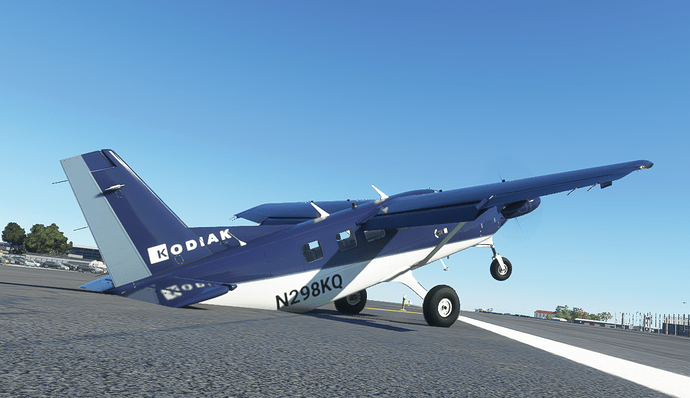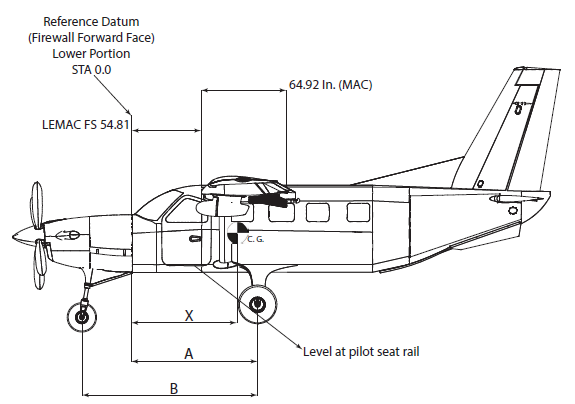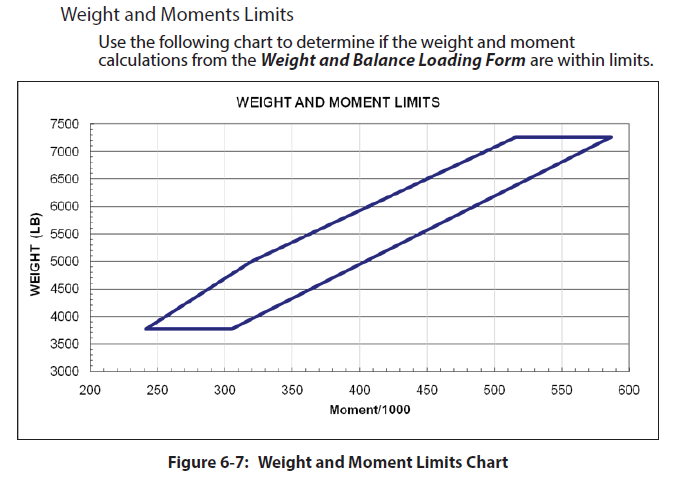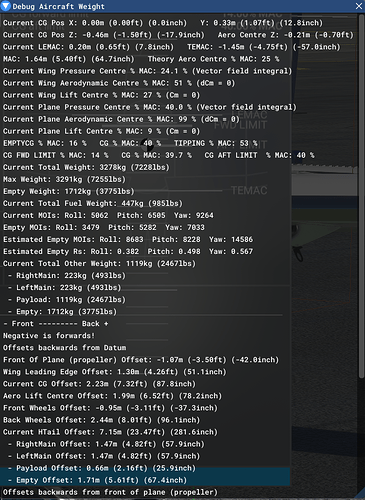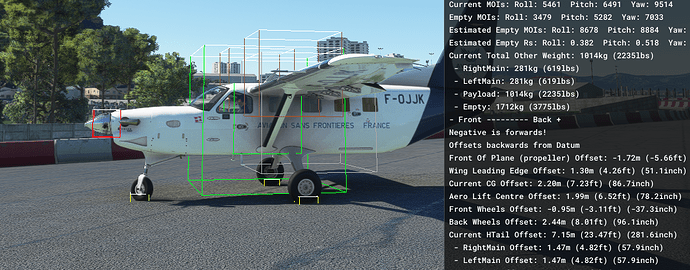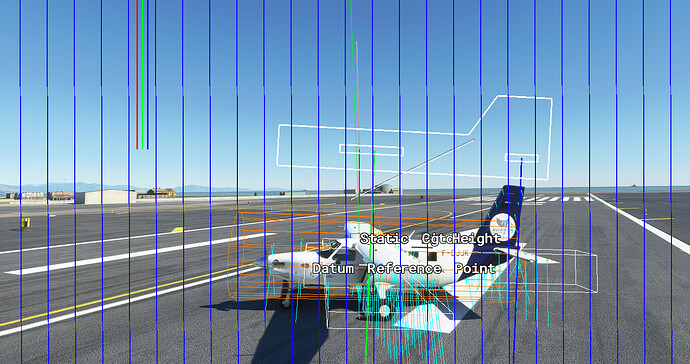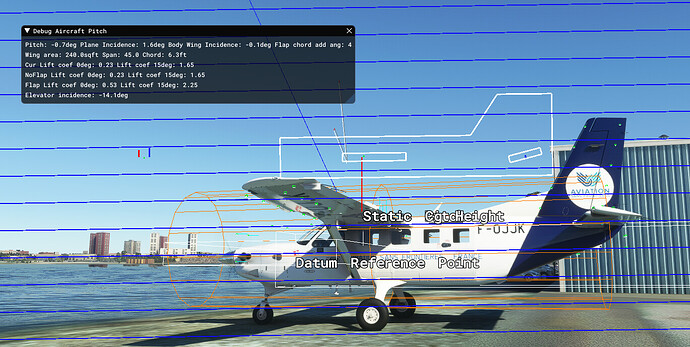We have encountered a strange behaviour with the Kodiak. Here are the steps
and what happens:
- Load the plane close to its maximum permitted aft CG, which is 40%
- Hold the brakes
- Increase power to 100%
- Release brakes
- The plane will fall on its tail (screenshot)
We initially attributed this to
prop wash and reduced it, but nothing changed. It also happens with full trim
down and full elevator down, so the elevator has absolutely no effect on this
and nor does propwash, it seems. It only happens:
- at high throttle settings of more than 80-85% and
- brakes released and
- speed less than 20kts
- CG beyond 35% (maximum is 40% for this aircraft)
If the plane accelerates past 20kts, I can throttle up to 100% and all is
working as it should. After running some tests and monitoring “ROTATION
VELOCITY BODY X” I noticed that at lower weights with brakes held, the plane’s
pitch will fluctuate at the 2nd decimal, which increases as you put more
throttle to the plane. As soon as you release the brakes, the plane shows a
nose-up pitch rate which is negligible at lower weights/forward CGs. If your
CG is way back (always within the limits), that pitch-up tendency very rapidly
increases to 7 deg/sec resulting in a tailstrike, as the elevator doesn’t work
to negate it. It seems like the plane does the rear-tilt as an “opposite” to
the forward tilt it does when braking.
Interesting case, it could be that your CG is seating slightly behind the main
gear, and on the other hand, with the CoL in front of the CG, the prop wash
induced lift increase and the plane light enough, a nose up moment is created
and sits the plane on its tail. Of course, that is pure conjecture.
@boufogre it is aheadof the main gear. Still, the
torque lever isn’t long enough for weight to cause that kind of a problem and
the plane is at its max weight when this happens.
@SWS-AlexVletsas, maybe the weight alone is too weak, but the weight plus the
lift induced moment might be enough. I’m not saying it happens IRL but maybe
the effect of the propwash on lift is too high.
Hello Alex. We reviewed you aircraft with some Asobo plane devs. Although we
were not able to identify any major issue on the FM side and on your
configuration side, here’s a list of potential adjustments that could help. -
Your engine seems to be misplaced, the Engine.0 parameter in the
GENERALENGINEDATA section does not define the position of the engine CG
but the position of its thrust so it should be shifted towards the propeller.
The doc is not very clear about that and will be improved. - Unrelated but
also check your ThrustAnglePitchHeading values, 2° seemed a bit high to
us. - Are you a 100% sure about your empty CG position? It seemed very
unusually shifted to the rear to us. - When the CG is at 40%, the lift center
ends up in front of it. Is that the actual aircraft behaviour? - Last but not
least, what does the flight manual say about flying in this configuration? Is
going full throttle and instantly releasing the brakes something that is
actually done with the real aircraft? As a last resort, something we can also
suggest and we’re sometimes using to increase our aircraft handling on ground
is to slightly shift the position of the rear gear contact points. You can
check our Cessna Caravan, it has a very similar configuration but without that
tailstrike issue. Let me know if any of this is helpful. Regards, Sylvain
@boufogre the propwash effect on the elevator is
very low and this is already 10 times lower than it was in the previous
iteration. pitch_moment_delta_elevator_propwash = -0.00498
pitch_moment_pitch_propwash = 0 Another thing that lead me to think that this
isn’t propwash related is that no amount of elevator down will hold the tail
up. The tail is completely ineffective, it looks to be a momentum thing.
There is definitely something going on with the CP and the CG, especially with
swept back wing, where the MAC position gets shifted forward with increasing
sweep angle when it shouldn’t happen. I think that for the sim, the MAC is the
wing section at the centre of the fuselage, which is wrong. When sweep is set
to 0, then MAC and CG positions make sense and are as defined in the
configuration files.
@FlyingRaccoon a small update, behaviour also
exhibited at 31% CG, 6000lbs. Even weight distribution, all weights set to
111lbs, 50% fuel. It seems to be fundamental. 29.9% seems to be the limit of
normal behaviour.
@FlyingRaccoon
@boufogre I observed something very strange while
debugging the aircraft. In the weight & balance section debug window, the
centres aren’t stable but are bouncing:
- Wing Pressure centre: 23-25%
- AeroCentre: 40-70% (too fast to see if it goes elsewhere too)
- Lift Centre: 26-27%
- Aircraft pressure centre: 30-70%
Also, I think I found the source of the problem. Snapshot of aircraft weight
debugger attached below.
- MAC length: 64.92 inches (manual), 64.7 inches (sim). Close enough
- Wing Leading edge offset: 51.1 inches. That’s 3 inches further forward to what it should be. Probably our problem, working on it.
- Centre of gravity empty: 16%, tipping: 53%
- Centre of gravity at 22% MAC
- Manual: 0.40MAC + LEMAC = 0.4064.92+54.81=69.06 inches aft if datum
- Simulator: 76.3 inches, which is equivalent to 28%CG and not 22%!!!
- Centre of gravity at 29% MAC
- Manual: 0.29MAC + LEMAC= 0.2964.92+54.81=73.64 inches
- Simulator: 80.9 inches, which is equivalent to 40.2%, which is slightly past the limit
- Centre of gravity at 40% MAC
- Manual: 80.904 inches
- Simulator: 87.6 inches, equivalent to 50.5%, way behind the limit. That might explain why the plane is tipping
The wing dimensions were defined based on the factory 3D model, so we are sure
they are correct. There are three possibilities I can see:
- We misplaced the aero centre by 3", which seems to affect CG calculations. That seems to account for 3" of error
- the simulator miscalculates CG% in conjunction with MAC length. We are off by 3 inches. Where do the remaining 4.5 inches of error come from?
Also another thing that caught my attention (images 2 & 3) is that as you
change the CG, under Aerodynamics debug, the simulator seems to be moving the
CP and wing position fore/aft on the aircraft caricature. It may be that you
do it on purpose (redraw the wing instead of the vectors), but I am posting it
here nonetheless. Watch the wing position relative to the weights. Lastly, why
does this happen only after releasing the brakes and applying power? If it was
strictly an aerodynamic/balancing problem, the plane should tailstrike even
with the brakes held. Why does it happen only AFTER releasing them? CG bugs
aside, it almost seems as if you’re forcibly pressing on the nose gear with
brakes set (momentum) and when they are released, it springs back and raises
the nose. Edit : After correcting LEMAC position (54.1 inches aft of datum
as per the manual), the EWCG of the aircraft now sits at 11% (with the 3"
error it was sitting at 16%), making the plane out-of-balance from the get-go!
In the aircraft.cfg empty_weight_cg_position hasn’t been touched and is
6.027ft behind the datum. In the debugger, the current CG offset is 72.3
inches. That would mean a CG of: (72.3 - LEMAC) / (MAC length) = 27% and
change. While the sim sees the correct distance, its CG% calculation is off by
16%! Furthermore, now at max gross weight my CG is 34.09%, but the
calculation says 87.1 inches, which in reality corresponds to almost 50%CG.
Bottom line: the distance of the CG seems to be correct, but the percentage
calculation seems to be off and we don’t know why. Furthermore, the CG
offset seems to be a factor of weight distribution alone and doesn’t take the
EWCG and empty aircraft weight into consideration. If I load all stations
with 100lbs, I get a CG offset of 82 inches. If I load all stations with
220lbs, I get 87.6 inches of CG behind the datum. While that may is right if
we’re only talking about cargo, it isn’t right when we talk about the entire
aircraft. The effect of the cargo to the total CG position should be
equivalent to the ratio of the payload weight/total weight. In MSFS, the CG
position seems to be taking into account only the cargo weight. Changes done
to flight model for this : aero_center_lift changed from -0.7 to -0.95
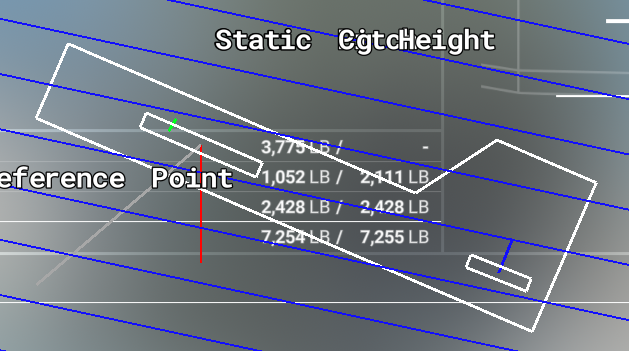
@SWS-AlexVletsas, do you have any wing sweep defined in the config file?
Can you try with 0 if your calculations make more sense?
Bringing some history into this, back in April and June (SU3 & 4) we weren’t
having that problem. It seems to have come into play after SU5. To verify
this, I ran the following tests to narrow down the issue. Ran tests using:
- April/June flight model and current SWS engine: Tailstrike
- April/June flight model and C208 engine at correct position: Tailstrike
- November flight model and current SWS engine: Tailstrike
- November flight model and C208 engine: Tailstrike
Tailstrike configuration
@FlyingRaccoon What was interesting was the elevator’s behaviour on the
ground. When I push the yoke forward on the ground, the nose wants to go up
and when I pull it wants to pitch down. As soon as you’re airbourne, it works
normally. I tested the default C208 and it doesn’t have such an issue. I also
checked the various values that Paul used, in case a + should have been a -
and vice versa. All is in order. So what is up and why is the elevator working
backwards on the ground? As we didn’t use 0,0,0 as our reference datum, could
there be a miscalculation that causes this? Also an academic question (I’m not
an FD guy): what are the three lines to the left of the aircraft figure (red,
green, blue vertical)?
More info: When on the ground, the elevator incidence is inverted to when in
the air. The little aircraft figure of the debugger shows “elevator up” when I
visually have “elevator down” and vice versa. The problem seems to be when
you’re below the stalling speed. All is fine in the air.
The only situation I would think makes sense for the Elevator being inverted
in during low speed taxi with a tailwind, for example, which you would need to
make opposite movement, yoke forward for nose up, and yoke back for nose down,
to keep the airplane stable during heavy wind, as needs done in TailDraggers.
Do you have any heavy wind acting on your plane at the time of these testing?
@Alec246 testing is always done on an ICAO standard day with no wind.
Update on the subject. @FlyingRaccoon helped
re-position the wing and CG. The good news is that now the CG doesn’t result
in a tailstrike, so half the problem is fixed. The other half of the problem
is that below stall speeds, the elevator works backwards.
pitch_moment_delta_elevator, when outside the prescribed values of [-5,-1] can
cause this, although it shouldn’t. Ours is about -0.2, so we will set it to
-1.2 and see how it works.
Shoudln’t this legacy entry be completely disabled in the Modern FM?
The doc mentions it’s still used by the autopilot but it has obviously some
more influence on the modern FM. I’m trying to get that clarified.
